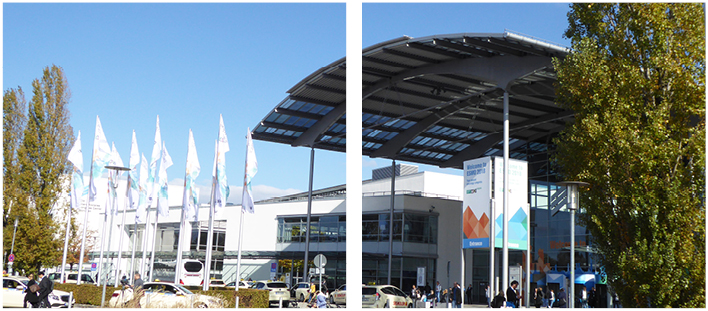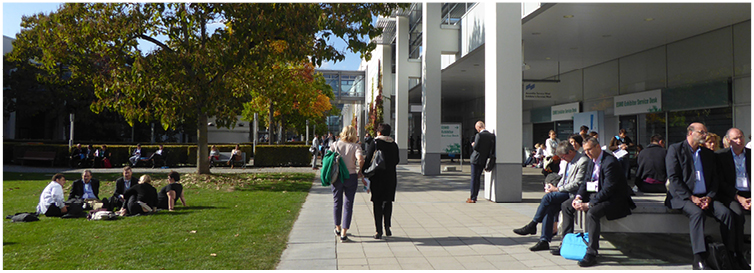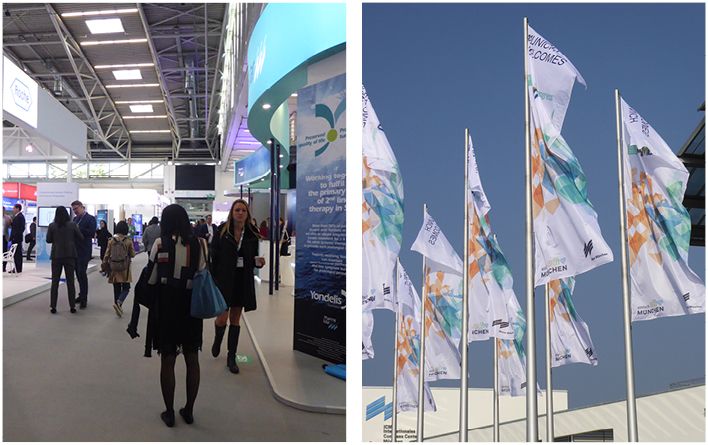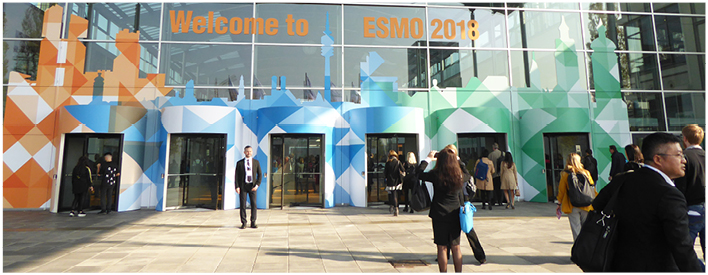Representing an essential platform for collective discussions on this year’s theme of ‘securing access to optimal cancer care’, the European Society for Medical Oncology (ESMO) Congress 2018 welcomed >26,000 oncology professionals through the doors of the Internationales Congress Center München (ICM) in the heart of Munich, Germany. Spanning 5 days, ESMO 2018 took place in the Bavarian capital from 19th–23rd October and involved a balanced programme of sessions, discussions, presentations, and debates. Herein, the EMJ provides their signature independent review of the congress for your enjoyment; whether you missed the event or would like to reflect on those amazing memories, the Congress Review section of EMJ Oncology 6.1 is not to be missed.
Welcoming attendees from across the globe at the inspiring Opening Session, ESMO President Prof Josep Tabernero highlighted the focus of ESMO 2018 as innovation, integration, and sustainability: all essential factors to ensure that cancer patients receive the best care. For the first time, the European Oncology Nursing Society (EONS) Congress took place this year alongside the ESMO Congress, and Dr Lena Sharp, EONS President, took to the stage to comment on this prime example of integration among oncology societies. Four outstanding professionals were then recognised for their contributions to the field of oncology, beginning with Prof Jean-Charles Soria who received the ESMO Award for his vital role in making precision medicine available to patients. The ESMO Award for Translational Research was presented to Prof Pasi A. Jänne for his discovery of EGFR mutations in lung cancer, followed by the ESMO Women for Oncology Award, which was bestowed to Dr Margaret Foti for her outstanding contributions to the development of women in oncology. Lastly, the ESMO Lifetime Achievement Award was received by Prof Tony Mok, who is well recognised for his practice-changing influences on the oncology community. With great applause and a huge sense of anticipation throughout the main auditorium, the ESMO 2018 Congress was officially underway.
During the next 4 days, a myriad of scientific sessions and lectures were available for attendees, covering hot topics such as Big Data, genomics, and immunotherapy. Other key parts of the programme were also well-attended, including the Young Oncologists track, which focussed on burnout among young professionals, and the Patient Advocacy track, emphasising the key parts patients play in the battle against cancer. As discussed, collaboration with the EONS was new to this year’s ESMO programme and offered oncology nurses a dedicated 3-day track to highlight the importance of their role in the multidisciplinary management of oncology patients. The vast congress programme developed by the ESMO 2018 Congress Officers will lead to transformations of oncology research into everyday practice.
This year’s ESMO Congress also featured three much-anticipated Presidential Symposia. Summarising the new data available from key cancer trials, these sessions provided delegates with a one-of-a-kind opportunity to learn from the very best researchers in the field; a summary of these fascinating session can be found within. By covering breast, prostate, and head and neck cancers, to name but a few, the presenters described their new results with the hope of providing answers to some of the questions surrounding effectively treating advanced stages of various cancer subtypes. To complement the array of scientific sessions on offer, attendees were also invited to the exhibition halls and the ESMO Society Village to browse the broad range of specialised companies and societies working to enhance clinical practice and patient care, providing delegates with a well-rounded insight into the world of oncology, from small-scale research to industry developments.
Other field-changing revelations from ESMO 2018 comprised the influence of exercise for lung cancer patients, post-chemotherapy effects on fertility outcomes, and the financial burden of disease for cancer patients, showing the true variation in education available to attendees at this inspiring event. Supplemented by summaries of a selection of ESMO abstract presentations, this Congress Review section provides a comprehensive summary of the 5 days in Munich and will inspire further debate and discussion throughout the coming year. Ready for even more ground-breaking developments from the oncology sphere, the EMJ team look forward to seeing you all at the ESMO Congress 2019 in Barcelona, Spain.

Short-Course Trastuzumab Proposals for Treatment of HER2+ Early Breast Cancer
A 9-WEEK COURSE of trastuzumab treatment for HER2+ breast cancer has been shown to be a viable alternative to the standard 12-month treatment and a treatment course reduction by even 6 months is cost effective, saving thousands of pounds per patient, according to the results of two studies presented in an ESMO press release dated 19th October 2018.
Non-inferiority of 6-month trastuzumab treatment compared to standard 12-month treatment was assessed by the Short-HER trial studying 1,254 HER2+ early breast cancer patients. Patients were randomised to receive either a 9-week or 1-year course of trastuzumab alongside chemotherapy. Patients were followed-up for a median of 6 years. Results showed that the shorter course did not achieve non-inferiority, but it was associated with a reduction in the rate of severe cardiac toxicity.
Subgroup analysis was then carried out to assess whether specific groups of patients would achieve non-inferiority when treated with the short course of trastuzumab. Pathogenic tumour (pT) size and nodal status (N) were found to be independent prognostic factors for disease-free survival. Patients with low and intermediate risk (pT <2 cm and No, and pT <2 cm and any N category, respectively) had similar 5-year disease-free survival with a 9-week course of trastuzumab (88%) compared to 1 year (89%; hazard ratio: 1.02; 95% confidence interval: 078–1.33). Risk of cardiac events was nearly 3-times lower for the 9-week compared to the 1-year groups (4.5% versus 12.8%).
The study was underpowered and therefore was unable to prove non-inferiority; 1-year trastuzumab remains the standard of care for HER2+ early breast cancer. However, Prof Pierfranco Conte, University of Padua, Padua, Italy, and lead author of the study highlighted that these results support the choice to stop trastuzumab treatment before 1 year in patients who develop a cardiac event without fear of compromising treatment efficacy.
A second study presented showed that a 6-month course of adjuvant trastuzumab was cost-effective compared to a 12-month treatment course. The landmark PERSEPHONE trial results analysing 3,759 patients showed an average cost saving of nearly £10,000 per patient. Further studies are needed to carry out further sensitivity analysis; however, Prof Claire Hulme, University of Leeds, Leeds, UK commented that: “The results, alongside the clinical effectiveness results demonstrating non-inferiority, are the first steps in the safe reduction of treatment for many women with HER2+ breast cancer. They present an opportunity for significant cost savings for health service providers.”
Use of Non-Conventional Therapies: Patient Perspectives
WHY do some patients with cancer make use of non-conventional therapies? And does this present oncologists with new challenges? These crucial questions were answered in studies presented at the ESMO Congress 2018, reported in a ESMO press release dated 10th October 2018.
Researchers from the University Hospital Mannheim, Mannheim, Germany used a structured survey to question 152 outpatients receiving care at a sarcoma centre on their use of non-conventional therapies. The patients had been treated for sarcoma, desmoid tumours, or gastrointestinal stromal tumour. The survey revealed the reasons why patients chose to make use of complementary and alternative medicines:
- To strengthen their immune system: 78%.
- To strengthen their body’s powers: 76%.
- To reduce tension and stress: 54%.
- To leave nothing unattempted: 53%.
- To do something for themselves: 49%.
- To fight the tumour: 45%.
- To reduce side effects: 37%.
- To detoxify: 34%.
The results also showed that just over half (51%) of the individuals had used alternative treatment methods previously and 15% had used alternative methods only during the disease. Furthermore, 44% of individuals reported that receiving a cancer diagnosis had galvanised their interest in alternative treatments.
Currently, ESMO has acknowledged the benefits of several non-conventional therapies: physical exercise, hypnosis, yoga, acupuncture, and mindfulness-based stress reduction programmes. However, there are several non-conventional therapies that ESMO does not recommend as they have been associated with no positive outcomes or with negative outcomes. These therapies include ozone therapy, herbs, minerals, antioxidant supplements, and high-dose vitamins.
It was found that although nearly half of patients asked their oncologist for information about the side effects of cancer therapies, oncologists did not represent the primary source of information about non-conventional therapies. In fact, only 7% of patients asked their oncologist about non-conventional therapies, suggesting a potential barrier to information. Instead, patients accessed information on the Internet and other media resources (43%), from their friends (15%), and from healing professionals (14%).
Speaking about these study findings on behalf of ESMO, Dr Markus Joerger, Cantonal Hospital, St Gallen, Switzerland noted that the fact patients did not perceive non-conventional therapies to be high risk was a significant problem for oncologists. He noted: “Patients tend to believe that supplements or herbs are generally safe, but they are not without risk. In daily practice, if you don’t know what your patient is taking as alternative medicine, the risk of drug–drug interactions can significantly increase and can have an impact on clinical outcomes.”
Financial Issues Impact Psychological Cancer Burden
INCOME LOSS, a significant financial concern for cancer patients, is associated with adverse psychological effects in addition to material hardship, according to the results of a German study. Supplementing American studies that have shown economic burden is associated with high cancer morbidity and mortality, these novel findings, detailed in a ESMO press release dated 16th October 2018, highlight the specific psychological impact of monetary losses for cancer patients and the absence of clear procedures to tackle this issue.
After conducting a systematic literature review of the tools used to measure financial cancer burden, Prof Eva Winkler, National Centre for Tumor Diseases, Heidelberg, Germany, and her team discovered a lack of European investigations into this topic. In line with ESMO’s key commitment to alleviate the financial burden of cancer, a questionnaire was created to assess this component of the disease based on material aspects, psychological effects, and behavioural changes, and a total of 247 patients (neuroendocrine tumours: n=122; colorectal cancer: n=125) provided responses. Between November 2016 and March 2017, 80.6% of patients stated that they had high cancer-related out-of-pocket costs, which could include co-payments for prescription drugs, travel expenses to care centres, and childcare costs. In addition, cancer-related income loss, mostly due to being unable to work or working reduced hours, was noted by 37.2% of participants and resulted in losses of >€800 per month for half of these patients.
While these results clearly showed the financial impact of cancer, particularly in German patients, further analysis indicated that the bigger the loss of income, the more negatively the patients perceived their quality of life, leading to higher levels of distress. “More research is needed to determine what actions are necessary at the system level, for example, an extension of the period of eligibility for sickness benefits, or at the individual level, like targeted consulting and support services,” commented Prof Winkler. Further assessments in other European countries are now warranted and development of a valid instrument to measure subjective financial burden in European patients is necessary to support their psychological wellbeing.

Adherence to Cancer Screening: EDIFICE Results
“IT IS CLEAR that oncology has shifted from being merely reactive to being proactive and cancer screening is fully in line with this idea,” said Prof Martin-Moreno, Medical School and Clinical Hospital, University of Valencia, Valencia, Spain, when commenting on behalf of ESMO on the results of a study into patient adherence to cancer screening. This study was reported in a ESMO press release dated 20th October 2018. Prof Martin-Moreno went on to state: “It [cancer screening] has the potential to make a major contribution to effective early diagnosis, if wide coverage, informed choice, and equitable distribution of screening services are ensured.”
Researchers in France have been investigating adherence to cancer screening for a number of years to better understand this issue. The EDIFICE programme has been running since 2005 and has been conducted every 3 years. The 2017 results were presented at ESMO. In the 2017 study, 12,046 individuals filled out an online questionnaire. Previous rounds of the programme had been implemented using a telephone questionnaire.
The 2017 results showed that participation rates for breast cancer screening were very high, with 94% of respondents stating that they had had a mammogram. Breast cancer screening is freely accessible to all women in France aged from 50–74 years old. However, despite these high uptake rates, it was noticed that those who were socially vulnerable were more likely to be reluctant to take part in screening programmes, leading the authors to speculate that breast cancer prevention was not a priority for this demographic. Social vulnerability was also a relevant factor regarding screening adherence in other types of cancer. For instance, socio-economic deprivation and living alone were associated with a reluctance to undergo cervical cancer screening. It was noted that those who were socially marginalised were also at greater risk of developing cervical cancer.
Another barrier identified to cancer screening uptake was that of medical scepticism. The researchers found that adherence to breast cancer and colorectal cancer screening programmes was negatively influenced by medical scepticism. Reasons mentioned were a lack of trust in the effectiveness of the protection offered by screening programmes and doubts about the progress of clinical research.
It is hoped that a greater understanding of patient adherence to screening programmes will enable improved uptake in the future.
Exercise Shown to Benefit Patients with Advanced Lung Cancer
FATIGUE and wellbeing were both improved when patients with advanced lung cancer undertook regular exercise, according to a ESMO press release dated 20th October 2018. Two studies highlighted the value of exercise for patients with advanced lung cancer, despite it previously being believed that only those with early-stage cancer would benefit from exercise.
An exercise survey was completed by patients at a cancer centre in Queensland, Australia; nearly 90% of those who completed the survey had advanced lung cancer. Results showed that 54% were unaware of the benefits of exercise and only 22% reached the healthy activity levels recommended by the World Health Organization (WHO). Over 60% of responders said they did not exercise because of fatigue or shortness of breath.
Data showed that patients who were less active had significantly less support than those who were more active. Researchers asked what type of exercise plan patients would find most helpful and most suggested more education, group exercise classes, and other support at the same location that they were receiving their treatment.
A second study (N=227) of patients with advanced or metastatic lung cancer randomised patients to receive either combined resistance and aerobic training for up to 45 minutes three times a week along with care management phone calls (CMPC) or CMPC alone for 24 weeks. Patients who completed at least 70% of the exercise sessions achieved significant benefits. Fatigue scores improved by 10% in the combined group, compared with 2% improvement for the CMPC only group (p=0.01). Functional wellbeing improved by 11% compared to 3% in the CMPC only group (p=0.03), and overall physical and functional wellbeing improved by 8% compared to 4% (p=0.04), respectively.
Dr Martijn Stuiver, Amsterdam University of Applied Medicine, Amsterdam, Netherlands highlighted that healthcare providers need to find out which type of exercise is most suitable to each patient and encourage them to conduct the exercise, highlighting the potential benefits. Dr Stuiver further emphasised the impact exercise can have on the treatment regime of cancer patients: “Physical fitness is a key factor in determining whether patients can start treatment and maintain dosing. Exercise may therefore become a primary adjuvant therapy to improve fitness so that patients are in the best possible shape to start or continue treatment and tolerate toxicities of other therapies.”
Single-Centre Experience of Post-Chemotherapy Fertility Outcomes
CHEMOTHERAPY’S impact on post-therapy fertility in breast cancer patients was examined by a study presented at the ESMO Congress and reported in a ESMO press release dated 20th October 2018. Today, individuals being treated for breast cancer aged under 40 are typically offered fertility preservation, as those who survive have a significantly reduced chance of pregnancy compared with the general population, being 70% less likely to become pregnant.
One of the main motivations behind the study was outlined by one of the study’s authors, Dr Jérôme Martin-Babau, Centre Armoricain de Radiothérapie, Plérin, France. He explained: “We wanted to find out whether the need and demand for it [fertility preservation] among breast cancer survivors was on a par with the level of investment and organisation called for by the policymakers.” The population studied were 60 patients who had been treated by chemotherapy for non-metastatic breast cancer. The median age of these women was 36 years at the time of diagnosis. All participants who undertook the survey were in complete remission. As the researchers expected, most individuals (83%) experienced a total absence of menstruation during the course of their chemotherapy regimen. However, a finding that was not expected was that 86% of those individuals declared that their menstrual cycles returned to normal within a year after the cessation of chemotherapy. Dr Marin-Babau commented this was “an indication that the treatment had not completely damaged their ovaries.”
The researchers found that the desire of individuals to bear children changed during the course of treatment. After treatment, 1 in 10 women stated they had plans to become pregnant, which contrasted with one-third of women prior to the commencement of chemotherapy. It was also found that of the six women who still desired children, four of them became pregnant, although two of these women miscarried. The researchers sounded several notes of caution about their findings, explaining that one-third of potential participants had not responded to the survey and that their findings reflected a single-centre experience.

Olaparib Extends Progression-Free Survival for Patients with Ovarian Cancer
OLAPARIB, a poly ADP ribose polymerase (PARP) inhibitor, has been shown to improve progression-free survival (PFS) substantially in patients newly diagnosed with ovarian cancer with BRCA1 or 2 mutations, according to the SOLO-1 Phase III trial data reported in a ESMO press release dated 21st October 2018.
A total of 391 patients with high-grade, serious or endometrioid ovarian cancer who were in clinically complete or partial response after chemotherapy were randomised 2:1 to receive either olaparib 300 mg twice daily tablets (n=260) or placebo (n=131) for 2 years. The study aimed to evaluate frontline olaparib maintenance therapy after platinum-based chemotherapy in patients with a BRCA mutation.
Median follow-up was 41 months. Primary PFS analysis showed a significant 70% reduction in the risk of progression or death for those treated with olaparib compared to placebo. Olaparib adverse events were low grade, with the most common Grade ≥3 toxicities being anaemia (22%) and neutropenia (8%). There was no clinically relevant change in quality of life between groups and only 12% of olaparib patients discontinued treatment, all of these patients did so because of associated toxicities rather than disease progression.
Dr Kathleen Moore, Stephenson Cancer Center, University of Oklahoma, Oklahoma City, Oklahoma, USA, further explained the results: “The median PFS for patients who received placebo was only 13.8 months, while the median PFS for those who received olaparib was not reached but looks to be approximately 3 years longer than the placebo group [hazard ratio: 0.30; 95% confidence interval: 0.23–0.41; p<0.0001].” Dr Moore went on to emphasise that current data suggest that >50% of olaparib-treated women were still progression-free at 4 years, compared to 11% of the placebo group.
“These are outstanding results in a worsening disease setting. Not only was olaparib efficacious but it was also shown to be well tolerated,” summarised Prof Isabelle Ray-Coquard, Université Claude Bernard Lyon Est, Lyon, France. These results are truly unprecedented and mark a dramatic change in the potential treatment for this subgroup of BRCA-mutated ovarian cancer patients; however, how these data could help in the treatment of other carcinomas still needs further investigation.
Immune Checkpoint Inhibitors Effective in Mismatch Repair-Deficient Colorectal Cancer
CHECKPOINT inhibition with nivolumab and ipilimumab has been shown to be highly effective in early-stage mismatch repair-deficient (dMMR) colon cancer patients. This first-of-its- kind Phase II trial was presented at ESMO 2018 and the results, described in a ESMO press release dated 22nd October 2018, were far more significant than those from studies of metastatic colorectal cancer.
As immunotherapy is already an established treatment strategy for many tumour types, showing durable responses in metastatic colorectal cancers, researchers from the Netherlands Cancer Institute, Amsterdam, Netherlands, set out to investigate its use in dMMR early-stage colorectal cancer, which has a high mutational load and immune checkpoint upregulation. The exploratory trial recruited 14 patients with early-stage colorectal cancer, 7 of whom had dMMR tumours. The patients were treated with nivolumab (two 3 mg/kg doses on Day 1 and Day 15) and ipilimumab (one 1 mg/kg dose on Day 1) to enhance the immune response by blocking programmed cell death protein-1 and cytotoxic T lymphocyte-associated protein-4, respectively.
Defined as <5% of viable tumour cells remaining, major pathological responses were noted in 100% of the patients with dMMR colon cancer following treatment, with 57% of these patients experiencing complete responses. In contrast, those patients with mismatch repair-proficient cancer did not show any major pathological responses. Commenting on the significance of this first study of immune checkpoint inhibitors in early-stage colon cancer, lead author Dr Myriam Chalabi, Netherlands Cancer Institute, explained: “For dMMR tumours, the results were amazing, with 100% of patients so far having either complete or near complete responses within the short timeframe, which is usually 4 weeks.”
While the small sample size and lack of control arm are two limitations of this study, the authors hope that the results will have implications for clinical practice in the future. “Our data suggest that neoadjuvant immunotherapy in dMMR colon cancer warrants further research and has the potential to change the standard of care,” commented Dr Chalabi. Further larger studies of immunotherapy in the neoadjuvant setting and for earlier-stage tumours are therefore necessary to replicate these findings.
Immunotherapy’s Impact on Triple Negative Breast Cancer
TRIPLE NEGATIVE breast (TNB) cancer is the most aggressive form of breast cancer. Relatively rare, TNB primarily affects younger women, and, once metastatic, the median TNB survival time is 12–15 months. However, a new therapeutic hope has emerged in the results of a recent Phase III trial, which were reported in a ESMO press release dated 20th October 2018, that investigated the effects of an atezolizumab– nab-paclitaxel therapeutic combination.
TNB cancers do not express oestrogen or HER2 receptors, thus the resistance of the tumours to hormone therapy or HER2-based therapeutics leaves chemotherapy as the sole treatment option; however, most patients develop resistance to chemotherapy within a few months. The new combination therapy has shown great potential in TNB care. “Atezolizumab in combination with nab-paclitaxel is the first targeted treatment to improve survival in metastatic triple negative breast cancer,” explained Prof Peter Schmid, St. Bartholomew’s Breast Cancer Centre, Barts Health NHS Trust; Centre for Experimental Cancer Medicine, Barts Cancer Institute, Queen Mary University of London, London, UK.
In total, 902 metastatic TNB patients who had not previously received treatment for metastatic disease were enrolled into the trial and randomised to receive either the standard chemotherapeutic, nab-paclitaxel, with the PD-L1 targeting antibody, atezolizumab, (combination) or nab-paclitaxel with a placebo (control). Across the entire study population, median progression-free survival and overall survival were both higher in individuals receiving the combination therapy compared with the control group: 7.2 months versus 5.5 months and 21.3 months versus 17.6 months, respectively. Focussing more specifically on patients with PD-L1 positive cancers, median progression-free survival and overall survival were 7.5 months versus 5.0 months and 25.0 months versus 15.5 months, respectively.
With limited side effects, most of which were attributed to the chemotherapy rather than the PD-L1 antibody, atezolizumab combination therapy appears to be a promising option for future TNB treatment, especially for those with PD-L1 positive cancers. Prof Schmid concluded: “Immune therapy on top of standard chemotherapy prolonged survival by ten months in patients with tumours expressing PD-L1. This combination should become a new treatment option for patients with metastatic triple negative breast cancer.”

Age: A Barrier to Clinical Trial Participation?
AGE LIMITS for participation in clinical trials were the focus of a study that was presented at the ESMO Congress and reported in a ESMO press release dated 21st October 2018. The study authors set out to examine whether young individuals (aged from 12–25 years old) had access to clinical trials.
On one hand, those under the age of 18 years are barred from taking part in adult clinical trials in Europe, as the legal minimum age is 18 years nearly everywhere. One of the study authors, Dr Aurore Vozy, Gustave Roussy Institut de Cancérologie, Villejuif, France, gave an example of how this could be problematic: “We know, however, that certain girls will develop genetically-driven breast cancers very early in life; there are no paediatric trials for this disease, yet these patients are systematically barred from participating in the relevant adult trials.” The alternative situation is that young adults in their early twenties can develop tumours that more typically occur in children; however, paediatric clinical trials will tend to have an upper age limit of either 18 or 12 years.
In order to examine the extent of this potential issue, the researchers reviewed all of the Phase I and Phase II trials that were initiated for solid tumours or lymphomas at the Gustave Roussy Institut de Cancérologie from 2012–2017; this encompassed 465 trials, of which 65 allowed the enrolment of individuals aged 12–17 years. Examination of the 389 trials that were not available to adolescents determined that 55% of them had the potential to be relevant for that demographic; furthermore, 28 of the trials were investigating tumour types that are especially common among adolescents. Examination of the 62 paediatric trials revealed that >50% did not recruit patients who were aged from 19–25 years. However, 10 of these trials were investigating tumour types that occurred in the 19–25-year-old age bracket.
Dr Vozy suggested several potential solutions:
- Increasing the age limit in paediatric trials to 25 years in certain cases.
- Lowering the minimum age to participate in clinical trials to 12 years, which has already been adopted in the USA.
- Including dedicated adolescent cohorts within adult clinical trials.
ESMO have already begun working towards the removal of these barriers. In conjunction with the European Society for Paediatric Oncology (SIOPE), they created the Cancer in Adolescents and Young Adults Working Group in 2016. The aim of this group is to both raise awareness of such barriers and work to influence authorities and stakeholders to facilitate the amelioration of the barriers.
Checkmate, Cancer! Positive Results for Immunotherapy to Treat Colorectal Cancer
LATE-BREAKING results from the CheckMate-142 trial suggest that immunotherapy with nivolumab and a low-dose ipilimumab could represent a promising first-line treatment for some forms of metastatic colorectal cancer. These findings, reported in a ESMO press release dated 22nd October 2018, build on previous results from the same trial that led to the treatment combination’s authorisation by the U.S. Food and Drug Administration (FDA).
Unlike previous reports, the latest CheckMate-142 results from the study focussed on patients who had received no initial treatment for microsatellite instability (MSI)-high colorectal cancer. In total, 45 patients (median age: 66 years, 51% male) were treated with the nivolumab–ipilimumab combination; they were followed-up for endpoint response for a median of 13.8 months.
The results of this treatment were hugely positive, with 60% of patients achieving the objective response rate, 7% having a complete response, and 84% of patients demonstrating tumour shrinkage. The 12-month progression-free survival and overall survival were similarly encouraging at 77% and 83%, respectively. The low dosage of ipilimumab resulted in decreased toxicity, with 16% of patients reported to have experienced treatment-related Grade 3 and 4 toxicities and 7% discontinuing treatment as a result.
This effective treatment could have a huge impact on the lives of MSI-high metastatic colorectal cancer patients, offering clinicians a first-line option with proven efficacy. “The combination of low-dose ipilimumab and nivolumab has a durable clinical response and is well tolerated as a first line treatment in patients with MSI-high metastatic colorectal cancer,” explained study author Prof Heinz-Josef Lenz, University of Southern California Norris Comprehensive Cancer Centre, Los Angeles, California, USA.
Further study, particularly a Phase III trial, is required before these results can be verified but, nonetheless, these results represent an important development for the treatment of this at-risk population.
First Overall Survival Results for Palbociclib
THE FIRST overall survival results from a Phase III study for a cyclin-dependent kinase (CDK) 4/6 inhibitor were reported at the ESMO Congress and described in a ESMO press release dated 20th October 2018. Speaking on behalf of ESMO, Dr Carmen Criscitiello, European Institute of Oncology, Milan, Italy, declared: “These data were much awaited, as the clinical benefit obtained with CDK 4/6 inhibitors was incontestable, but there was the hot question whether the progression-free survival benefit translates into overall survival benefit.”
CDK4/6 inhibition treatment has been proposed as a possible solution for preventing or overcoming the development of resistance to hormonal therapy in advanced hormone receptor positive (HR+), HER2- breast cancer. The development of such a treatment is important as the majority of patients with HR+ breast cancer develop resistance to hormonal therapies over the passage of time. Previous results from the PALOMA-3 trial had revealed that palbociclib, a CDK 4/6 inhibitor, when used in combination with fulvestrant, resulted in an increase in progression-free survival in a group of 521 women with HR+, HER2- breast cancer who had progressed on hormonal therapy.
In a new analysis of PALOMA-3 data after a median follow-up of 44.8 months, the researchers carried out an overall survival analysis after around 60% of the patients in the trial had died. The results of the analysis demonstrated an increase in overall survival of 6.9 months (median overall survival: 34.9 months; 95% confidence interval: 28.8–40.0) in the palbociclib and fulvestrant cohort compared with the placebo and fulvestrant cohort (median overall survival: 28.0 months; 95% confidence interval: 23.6–34.6; p=0.043).
Dr Criscitiello concluded: “This randomised Phase III trial shows for the first time an improvement in overall survival with a CDK4/6 inhibitor in the metastatic setting for HR+, HER2- breast cancer.” She also noted: “This study was underpowered for overall survival, so the data should be cautiously interpreted. Although the results strongly suggest that the progression-free survival benefit may translate into overall survival benefit, the other trials conducted with CDK4/6 inhibitors will contribute to confirm the estimate of the overall survival benefit observed in this study.”

High Non-Adherence to Hormone Therapy in Premenopausal Breast Cancer Patients
TREATMENT with tamoxifen, a form of hormone therapy, is common for breast cancer patients, but new research presented in an ESMO press release dated 19th October 2018 indicates that adherence to the drug is concerningly low. While previous studies have shown many breast cancer patients discontinue long-term therapy, this study by the Institut Gustave Roussy, Villejuif, France, is the first to reveal the extent of treatment non-adherence within this population via serum level measurement after 1 year, as opposed to self-reported adherence.
Using data from the CANTO trial, a prospective study examining the long-term impact of breast cancer treatment side-effects in around 12,000 patients, the researchers analysed 1,799 premenopausal women who had been prescribed tamoxifen to treat their early-stage (I–III) breast cancer. The patients’ tamoxifen level within their serum was measured at 1, 3, and 5 years and their self-reported adherence rates were recorded.
After the first year, results showed that 16.0% (n=188) of these patients were not adequately adherent to the treatment, with serum tamoxifen levels of <60 ng/mL. Of these, 10.7% had an undetectable level of the medication, with the remaining 5.3% of patients shown to be poorly adherent, with serum tamoxifen levels below the expected steady-state concentration expected after 3 months. In addition, <50% of these 188 patients self-reported not taking their tamoxifen as prescribed.
These results are considerably higher than expected and pose a challenge to clinicians, who need to develop a personal relationship with patients to encourage them to openly discuss side effects and adherence with their physician. “We need to understand the patients most at risk of being nonadherent early in their treatment and provide targeted interventions aiming to improve their self- efficacy and self-management of side-effects,” explained Dr Barbara Pistilli, Institut Gustave Roussy, Villejuif, France.
While the wider application of these results was limited by the French-only cohort and the fact that data was only recorded at one timepoint per year, they still represent an important step in encouraging further doctor–patient discussion in the management of breast cancer. The study remains ongoing, awaiting data from its 3 and 5-year endpoints, which will be better able to quantify the impact of non-adherence on mortality and recurrence.
Renal Cancer Revolution: Avelumab plus axitinib combination proving effective
PREVIOUSLY untreated renal cell carcinoma (RCC) patients could benefit from a combination therapy comprising the immune checkpoint blocker avelumab and the tyrosine kinase inhibitor (TKI) axitinib, suggest data from the JAVELIN Renal 101 trial presented in a ESMO press release dated 21st October 2018. “JAVELIN Renal 101 is the first positive Phase III study combining an immune checkpoint blocker with a TKI alone in the first line treatment of advanced RCC,” commented Dr Robert Motzer, Memorial Sloan Kettering Cancer Center, New York City, New York, USA.
In total, 886 kidney cancer patients (Memorial Sloan Kettering Cancer Center) were examined; 442 were administered the oral avelumab–axitinib combination (avelumab 10 mg/kg intravenously every 2 weeks, axitinib 5 mg twice daily), while the remaining 444 were given 50 mg oral sunitinib once per day on a 4/2 schedule (4 weeks on-drug, 2 weeks off-drug). The study’s primary endpoints were PFS in PL-L1+ patients up to 30 months, and overall survival in these patients up to 5 years.
Results of this new treatment combination were encouraging, with a median PFS of 13.8 months in the combination arm versus 7.2 months in the sunitinib arm (hazard ratio [HR]: 0.61; p<0.0001) in patients with PD-L1+ tumours; when assessed irrespective of PD-L1+ expression, PFS was 13.8 and 8.4 months, respectively (HR: 0.69, p=0.0001). Additionally, the confirmed objective response rate was shown to be more than doubled in the combination arm (55.2%) versus the sunitinib arm (25.5%) (95% confidence interval: 49.9–61.2 and 20.6–30.9, respectively). “The combination benefit was shown in all subgroups of patients by independent review as well as by investigators, and whether tumour cells stained positive for PD-L1 or not,” explained Dr Motzer.
These results represent response rates that are twice those of the current standard of care and, whilst further study is warranted, this combination could be a powerful option for this vulnerable patient cohort. “TKI, and checkpoint blockers like avelumab, both may have potential immune-modulating functions that, when combined, may provide clinical benefit in patients with advanced RCC that exceeds the effects of the respective drugs alone, without compromising toxicity,” concluded Dr Motzer.
Cancer Drug Reimbursement Approval Time Varies Across Europe
DISPARITY in the time taken for health technology assessment (HTA) decisions regarding the reimbursement of new anticancer drugs following European Medicines Agency (EMA) approval has been highlighted between various European nations in the results of a new study, which was presented at the ESMO Congress and reported in a ESMO press release dated 19th October 2018. Some countries were shown to take >3-times as long to approve reimbursement.
A HTA process has been adopted by many European countries. The process involves undertaking a systematic cost-benefit analysis of a treatment once it has been approved by the EMA. This process is conducted prior to determining whether or not to reimburse the use of the treatment for routine patient care.
The researchers focussed their attention on four countries: England, Scotland, France, and Germany. They tracked the time between EMA approval for the 47 drugs approved for use in 77 solid tumour indications from January 2007–December 2016 and HTA decisions being made by the health authorities in the four countries. The findings revealed a significant discrepancy in median time from EMA approval to HTA decision:
- England: 405 days.
- Scotland: 384 days.
- Germany: 209 days.
- France: 118 days.
It was also found that the drugs ranked as being of the highest benefit on the ESMO Magnitude of Clinical Benefit Scale (ESMO-MCBS) had a decision made on them more swiftly. These were typically approved for reimbursement, with Germany approving all such drugs, Scotland 95%, England 92%, and France 90%.
The overall findings represented sobering news, Dr Bettina Ryll, Chair of the ESMO Patient Advocacy Working Group, declared: “We in melanoma still mourn the lives we lost due to the tardy and inconsistent introduction of approved innovative therapies.” Dr Ryll went on to issue a call: “It is a country’s responsibility to ensure sufficient administrative capacity so that processes like HTA that were put in place for the benefit of society do not start harming citizens. And we need more pragmatic approaches to reducing uncertainty; simply letting patients die while waiting for data to mature is not a civilised option.”
In addition to ensuring sufficient administrative capacity, it was also suggested that HTA agencies could use the ESMO-MCBS as a decision-making tool. As only four countries were investigated in this study, insights into HTA procedures in other European countries may prove equally enlightening.

New ESMO Designated Centres of Integrated Oncology and Palliative Care
“ESMO is committed to increasing awareness and education to bring patient-centred care closer to all professionals, to improving collaboration between healthcare providers for the good of patients and to promoting research, so that patient-centred interventions are not only integrated, but also based on the best evidence.” These words are taken from a ESMO position paper published in 2017, in which ESMO declared that supportive and palliative care should be a core component of therapy for cancer. It was in this spirit that the ESMO Congress saw the recognition of 20 recently accredited Designated Centres of Integrated Oncology and Palliative Care, as reported in a ESMO press release dated 16th October 2018.
The objective of the ESMO Designated Centre of Integrated Oncology and Palliative Care programme is threefold: firstly, to encourage national health bodies to integrate palliative care services into their cancer care guidelines; secondly, to promote the training and education of medical oncologists and other healthcare professionals in palliative care; and thirdly, to facilitate and expand ESMO’s work with other medical organisations and associations in the support of palliative care development. Designation as a Centre of Integrated Oncology and Palliative Care is valid for a 3-year period, after which reapplication is necessary.
Speaking about the importance of palliative care, one of the authors of the ESMO 2017 position paper, Dr Karin Jordan, University of Heidelberg, Heidelberg, Germany, stated: “Over the last decade, we have recognised that while survival and disease-free survival are both fundamental factors, overall quality of life is also crucial for patients. At any stage of the cancer pathway, physical, psychological, social, existential, and spiritual support and rehabilitation are often needed.”
Of the 20 centres to achieve ESMO Designated Centre of Integrated Oncology and Palliative Care status, 11 were from Europe, including the first centres from Denmark and Estonia. Other countries that saw their first Designated Centre were Japan and Qatar. Additionally, 54 centres achieved reaccreditation, which took the total of Designated Centres worldwide to 216, highlighting the increased reach of this ESMO programme.
Cancer Patients Share Experiences via Social Media
TWITTER can be used as a forum for sharing experiences of disease, and cancer is currently the most commonly discussed disease on the site. Presented at ESMO 2018 and reported in a ESMO press release dated 12th October 2018, a recent exploratory study analysed >6,000 tweets and retweets posted with the hashtag #BreastCancer, since this is the top cause of cancer-related deaths in women, showing that diagnosis, treatment, and prevention were among the most discussed topics.
“Many of the patients we see in daily practice use social media to search for information about their disease, so, as care providers, we wanted to know what kind of content they find there,” explained study author Dr Rodrigo Sánchez-Bayona, Clinica Universidad de Navarra, Pamplona, Spain. As part of a larger study that analysed the presence of different diseases on social media, breast cancer was chosen for this subanalysis due to its high prevalence worldwide. Tweets (n=3,703) and retweets (n=2,638) posted during a 7-day time period were categorised according to twitter user, content, user aim, and stigmatising attitude.
The results showed that while 1 in 3 tweets contained medical content, 40% of the tweets came from institutions or public accounts, resulting in 90% of the information being informative. In addition, 44.5% of the tweets were focussed on prevention and the most common aim of patients using Twitter was to share their cancer experiences. With regard to stigmatisation, Dr Sánchez-Bayona explained that the finding that <15% of tweets contained stigmatising statements could be attributed to the numerous successful breast cancer awareness campaigns and highlighted the importance of comparisons with the presence of other tumour types on social media.
The user information collected from this study will enable advocacy organisations to create relevant medical content specific to particular patients, as well as using social media to disseminate information to a broad audience. With such a rich pool of patient data available on Twitter, it was concluded that it may be effective at assessing attitudes to many types of diseases. “This analysis also illustrates the presence of patients in large numbers on Twitter. We should take that as corroboration of a new reality: patients now use the web to find information, and social media must be an integral part of our communication with them,” commented ESMO spokesperson Dr Marina Garassino, Istituto Nazionale dei Tumori, Milan, Italy. With the potential for fast and wide publication of medical content, it is expected that the use of Twitter for sharing both disease information and patient experiences will increase.
Precision Medicine Moves into the Oncology Community
TARGETED drugs for advanced cancers are being used in healthcare facilities other than highly specialised centres, according to results reported in a ESMO press release dated 9th October 2018. With more community patients being able to benefit from precision medicine in their treatment centres, targeted treatment is changing the way oncology patients are cared for, potentially enhancing survival and quality of life.
From 2013–2017, large-scale tumour profiling was performed on 6,177 patients with advanced cancer at 5 hospitals of Cancer Treatment Centers of America. Using the data to match patients to targeted treatment, 47% of the DNA mutations identified were clinically relevant and included alterations, most commonly gene amplifications (32%) and alterations in KRAS (23%) and PIK3CA (15%). A total of 57% of patients with DNA alterations matched to targeted therapies were receiving treatments approved by the U.S. Food and Drug Administration (FDA) for other tumour types, while 15% of the patients received treatments in clinical trials. The team noted that they hope the latter figure will increase to as high as 50% of patients receiving treatment through clinical trials or off-label with approved medicines in the next few years.
“It is so encouraging to see how precision medicine is changing the way we treat our patients in the community and our next step is to analyse the effects of targeted treatment on survival and quality of life,” elucidated Dr Ricardo H. Alvarez, Cancer Treatment Centers of America, Atlanta, Newnan, Georgia, USA. These results were welcomed by the authors’ European colleagues also, with Dr Joaquin Mateo, involved in the ESMO Scale for Clinical Actionability of molecular Targets (ESCAT), commenting: “This is an important study because of the large number of patients and what it tells us about the impact of genomic research on patient care and clinical decisions in the community where the majority of patients are treated.” In order to implement precision medicine within the oncology community and allowing it to reach a wider selection of patients, more detailed information on the use of tumour profiling to inform treatment decisions and the cost of analysing DNA samples is now required.
Treatment with Probiotics Reduces Chemotherapy- induced Diarrhoea
CHEMOTHERAPY-induced diarrhoea is a serious, but often under-reported, side effect as a result of current standard anticancer treatment. Chemotherapies can have a significant impact on the gut microbiome; however, the results of an Indian study, reported in a ESMO press release dated 21st October 2018, highlight the beneficial effects of probiotics on preventing diarrhoea.
“Chemotherapy-induced diarrhoea is an under-reported, unpleasant, and sometimes a serious side-effect of chemotherapy,” explained study lead Prof Atul Sharma, All India Institute of Medical Sciences, New Dehli, India when outlining the reasoning for the investigation. A total of 291 participants (80% of which were male and aged around 46 years) were randomised into two groups. One hundred and forty-five of the patients received two probiotic sachets a day containing 900 billion colony forming units of four different bacterial strains: 4 strains of Lactobacilli, 3 strains of Bifidobacteria, and 1 strain of Streptococcus thermophiles. The control group (consisting of 146 patients) received 2 sachets of placebo a day. Treatment regimens commenced 14 days before the initiation of fluoropyrimidine and/or irinotecan-based chemotherapy and continued until 2 weeks after the third chemotherapy cycle.
The study did not meet the primary endpoint of reducing Grade 3 and 4 diarrhoea incidences, with 8.0% and 2.0% of participants receiving probiotics reporting Grade 3 and 4 diarrhoea compared with 4.1% and 0.0% in the control group, respectively. However, overall administration of probiotics was shown to decrease the incidence of diarrhoea with 199 incidences reported in the probiotic group compared with 220 in the placebo group. The use of probiotics was also shown to reduce the levels of inflammatory markers, such as vascular endothelial growth factor, clusterin, and faecal calprotectin, the clinical significance of which requires further investigation.
Prof Atul Sharma concluded: “Though it did not meet its primary endpoint in reducing incidence of Grade 3 and 4 diarrhoea, it helped to reduce the incidence of all grade of diarrhoea.” The study again highlights the importance of a healthy gut microbiome and offers a potential solution to one of the most common adverse events as a result of chemotherapy.







